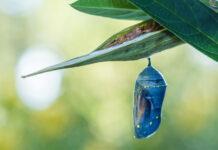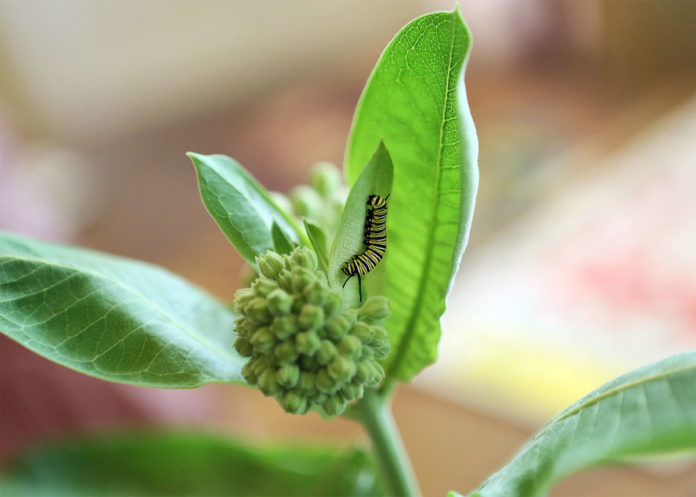
[Submitted Featured Image – Photo by Mary Torgusen – For 10-14 days the caterpillars do nothing but “crawl, eat and poop” until it’s time to form their chrysalis.]
This is the second piece in a series about pollinator gardens. In the next two installments, Molly will be sharing stories from local residents and master gardeners, and even getting some hands-on experience designing and planting one of these gardens herself.
In the summer and early fall, you can see the orange flicker of a monarch butterfly in the river valley, flitting across flowers or landing briefly nearby. These monarchs are on one leg of a massive journey. And if a monarch you spotted was near Mankato, there’s a chance that journey began in Mary Torgusen’s home.
It started as an activity for the kids. Mary was running her daycare and needed something to occupy her young charges. A decade later, and the experiment-turned-hobby is still going strong.
A delicate process
I meet Mary in her home. It’s bright, cheerful and full of the giggles of her girls playing out back. Mary shows me the zinnias in her backyard, flowering impressively.
“They’re the best,” she says. “They grow everywhere, and the colors just draw everything in. The bees love them.” There is another pot overflowing with forget-me-nots. “My mother was the gardener, not me. She painted flowerpots and created a feeding ground.”
Everything sprouting was planted from seed and fertilized with only organic manure. It’s impressive and lovely, and it’s just the setting. Mary takes me to one of the many large milkweed plants in the yard. Monarchs prefer to lay their eggs near the top of milkweed, up and away from predators. She turns over a leaf, studies it briefly, then points out the tiny cream-colored speck: the monarch egg. This is where the journey starts.
First, you need a container. Mary uses a Rubbermaid and lines the bottom with a damp paper towel. The moisture promotes a healthy environment for the eggs. Then you cut away just the portion of the leaf with the egg attached to it. Leave the rest of the leaf alive on the plant, since it will feed and house other monarchs. Place the cut piece on the paper towel, and then you wait.
Within four days of laying, the egg will turn dark and hatch. The caterpillar will be the size of a pencil tip. (“Tiny, tiny,” says Mary.) You have to find the hatched caterpillar and separate it from the rest of the eggs since “they’re not too bright, so they’ll accidentally eat the other eggs.” Once you’ve found the teeny tiny caterpillar, move it to a living or very fresh milkweed leaf in an enclosure.
She turns over a leaf, studies it briefly, then points out the tiny cream-colored speck: the monarch egg. This is where the journey starts.
Mary has experimented with everything from laundry hampers to former snake pens and an old changing table.
“We got a little more sophisticated after that,” she says.
Make sure the enclosure has some natural light and is somewhat breathable and easy to maneuver for cleaning. The caterpillars won’t eat dried leaves, so only feed them fresh or living milkweed.
Growth spurt
Then it’s time for the “eat and poop” phase. Think The Very Hungry Caterpillar. For about 10-14 days, the caterpillars will pretty much just wander around looking for food and pooping it out. Clean the bottom of the enclosure regularly, and if you move in living milkweed in water, make sure the surface of the water is covered so the caterpillars can’t fall in and drown. Mary uses things like to-go cups with plastic lids to feed the milkweed stem through the straw hole and keep the caterpillars safe and fed. She says this is a favorite phase for the kids to watch. The caterpillars crawl about and eat rapidly, growing to 3,000 percent their birth size. Then, they move upwards, find a spot on the top of their enclosure and begin their next transformation. The newly formed chrysalis is bright green and sways gently with the breeze of the open door.
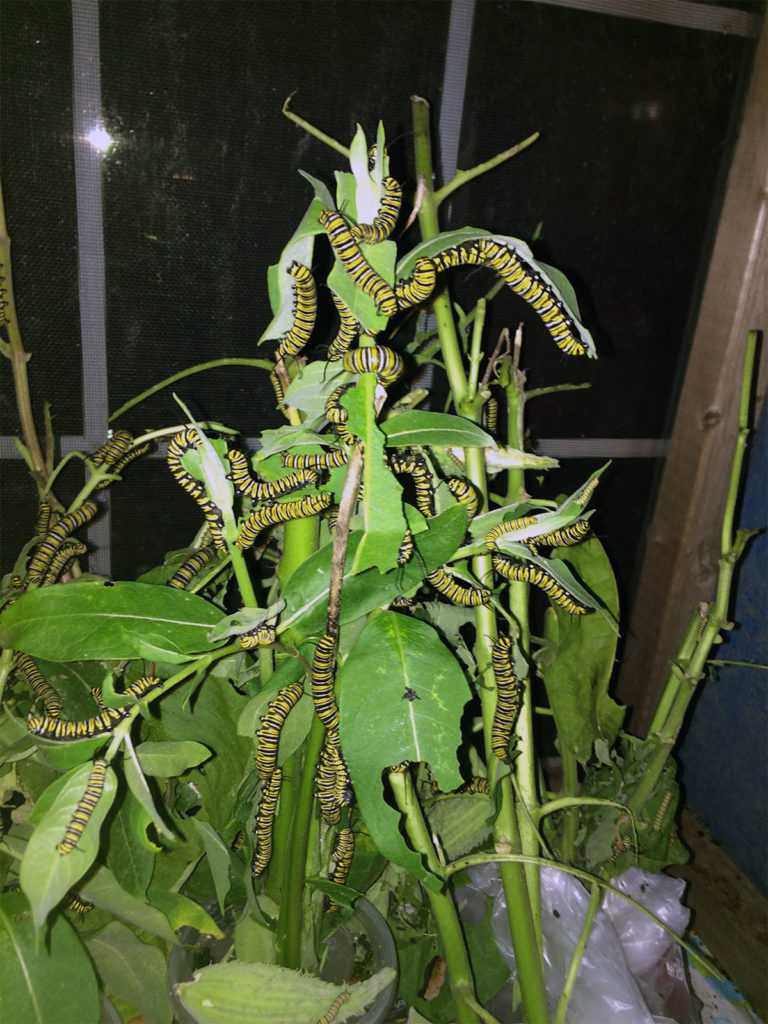
“If you hold a light up and look inside the green chrysalis, it looks like it’s just empty goop,” Mary says, demonstrating.
According to Journey North, a citizen science program that spans North America, this gelatinous “pupa soup” is actually complex: “At no time between egg fertilization and death do all body parts break down. Some do, but many don’t. Many of the features unique to the adult, such as the wings, eyes, internal reproductive organs, and long antennae, are actually present as tiny clusters of cells even in the egg.”
The chrysalis is strongly attached with a soft webbing. Mary detaches an empty chrysalis to show me. It looks like a tuft of a cotton ball, or a very thick spider web. Mary says she’s found them hanging on just fine outside, even after incredible storms. They stay in their chrysalis for about two weeks. Hatching can happen “within seconds.”
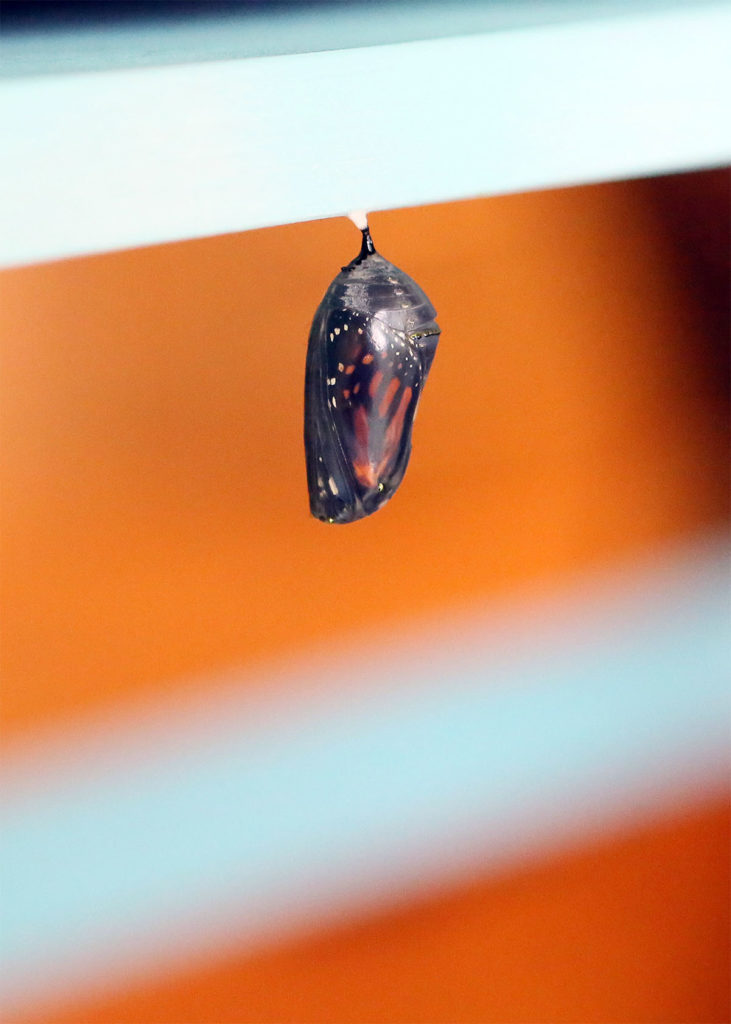
Once the butterfly has hatched, Mary lets it spend 6-8 hours in the pen after it opens its wings, just to make sure they’re stretched, dry, and ready to go. Then, and this is very important, she gently picks it up by pinching all four wings simultaneously. This prevents injury.
Then she takes it outside. Some fly away immediately, some hang out. Each one is special.
“It’s amazing to just watch them go.”
Moving memorials
Mary has taken on the very beautiful task of dedicating and sending her butterflies for loved ones. It started when her brother passed away, and, since then, her butterflies are always flying for someone.
“I sent one for my mom,” she says. “It was really special. I got to watch the monarch lay the egg, I raised it, and sent it to her.”
I sent one for my mom. It was really special. I got to watch the monarch lay the egg, I raised it, and sent it to her.
Friends, family, even strangers on Facebook reach out and ask her to send a butterfly for someone special to them. Since our interview, she has also sent one for the late Ruth Bader Ginsberg.
“This year we sent one for John Lewis, the Black Panther… We send them for friends, neighbors, anyone who asks,” she says.
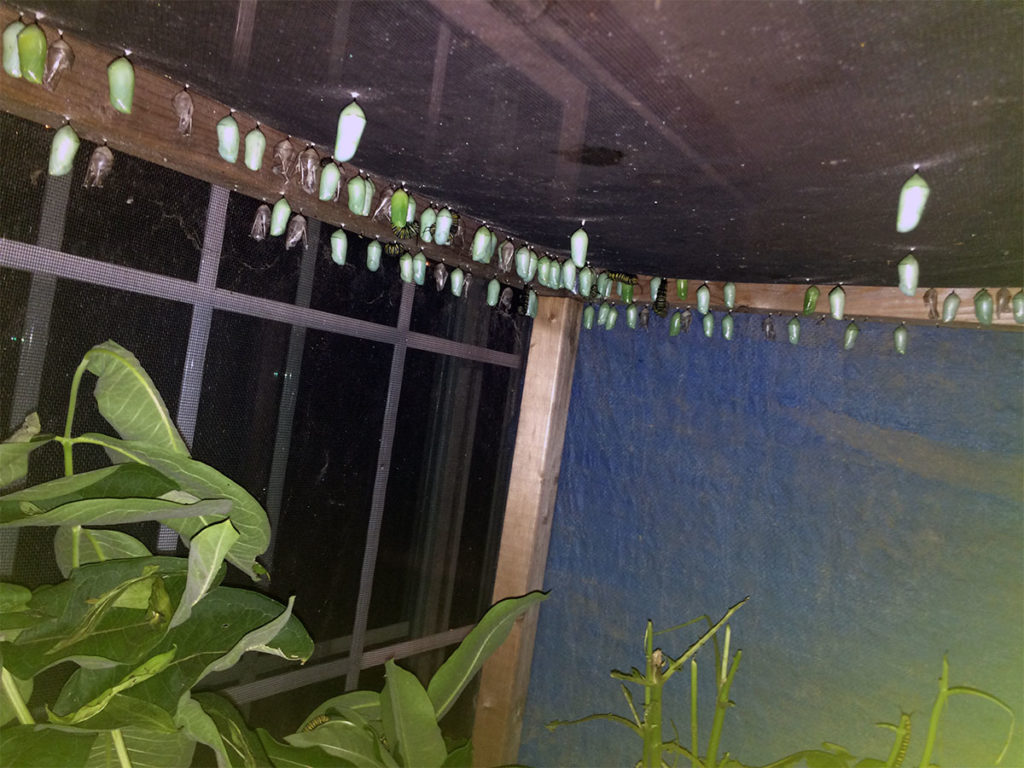
A bad year for butterflies
Mary says 2020 was a bad year for the butterflies. She found fewer eggs, only about 150, and only 56 reached adulthood. That’s still good, considering in the wild only 10 percent of the eggs laid will ever spread their wings. Back in 2017, she fostered close to 1,000 eggs and released about 500. She hopes for another healthy year like that soon.
This cycle is extremely delicate. Mary takes extra care to gently clean any incoming materials, like milkweed from friends. The fresh milkweed leaves she brings in to feed the caterpillars are always rinsed to remove any spiders or aphids from hitching a ride. Butterflies face numerous predators, including birds, wasps and mice, and there are also problems such as speeding cars and diseases.
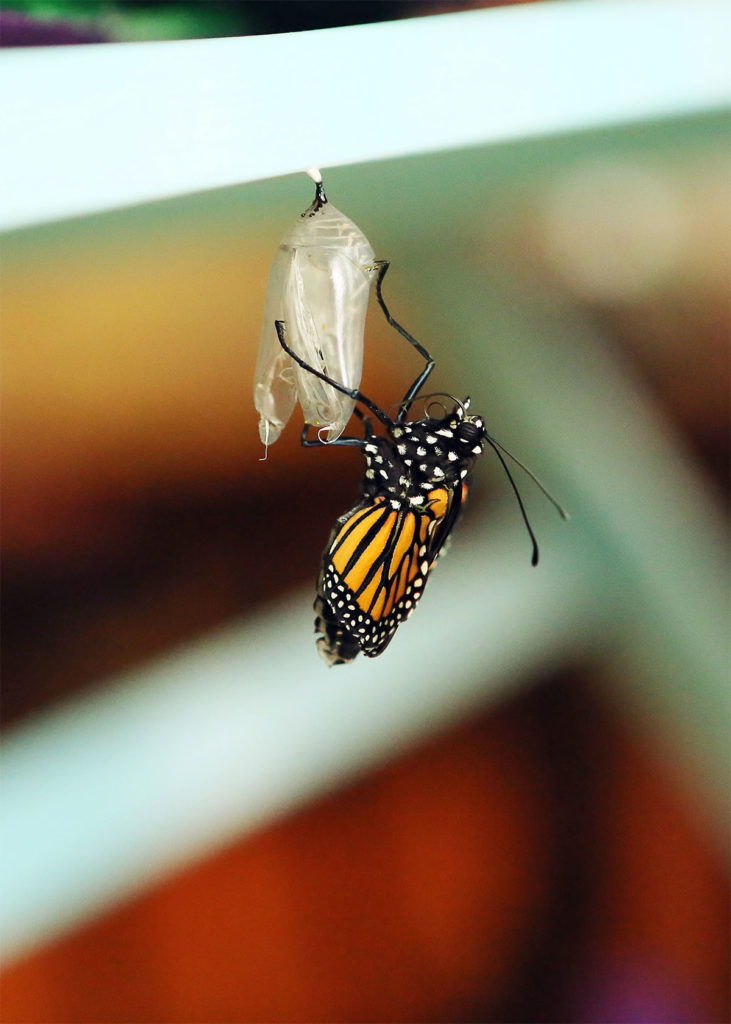
One of the diseases Mary has been fighting against in her butterflies is Ophryocystis elektroscirrha (O.E.). It causes the chrysalis to turn black and liquefy.
“It’s almost as if they get confused about where they are in their process,” Mary says. “They climb up too soon and don’t make it.”
The disease releases spores, so when one falls ill, Mary has to sanitize the entire enclosure to prevent the spread.
With a cycle so delicate, Mary asks those who care for the pollinators and especially the monarchs to refrain from spraying their lawns, or, at the very least, to leave parts of it untreated.
Carrying on the cycle
Mary joined this cycle a decade ago. She explains, “Right when I got started was when we had a major decline in the monarchs. People were trying things like shipping eggs where they weren’t laid to raise them, but that disrupted their migration. So, it’s best to raise them right where they’re laid.”
Since then, she has experimented with various containment methods, taped broken wings, faced disease and predators, and released hundreds of monarch butterflies. Mary is 100 percent self-taught, and that’s kind of the point.
Mary says some friends get really into it. They call her to say, ‘I saw one of yours!’ It seems the love of monarchs is contagious.
“I did this with the kids to help them learn how to research,” she says. “There are so many great sites.”
I ask if she’d recommend rearing monarchs to others.
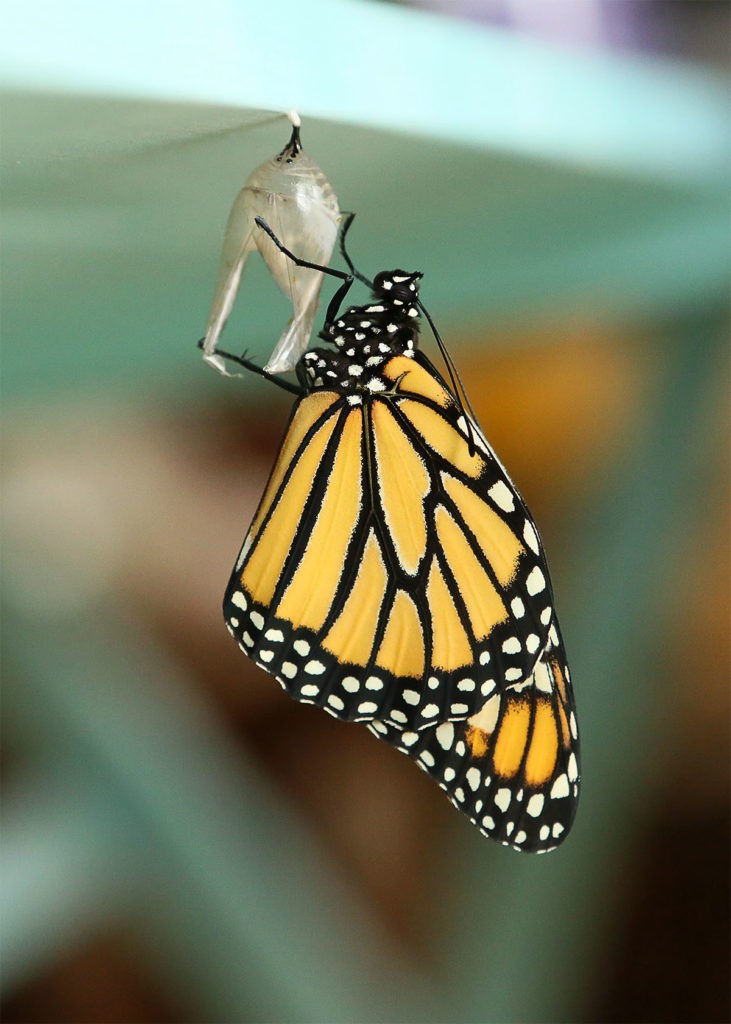
“Sure!” she says. “But start small. Bringing in too many at once, especially for beginners, can spread disease. The thing is knowing when its too many.”
Mary says some friends get really into it. They call her to say, “I saw one of yours!” It seems the love of monarchs is contagious.
There are plenty of resources online for anyone interested in helping raise these pollinators responsibly, including Save Our Monarchs and Monarch Watch. For now, follow along the migration on the Journey North Map and, like Mary, be ready for the cycle to begin all over again.
~~~
Green Earth is a regular column by Molly Butler focusing on a few of her passions: nature and the environment, with an emphasis on Blue Earth and Nicollet Counties.

